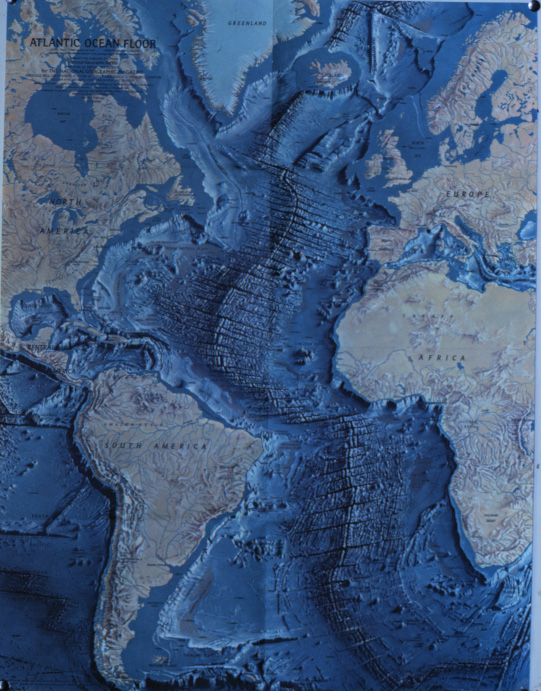
Click here to go to 'Figures/Overheads' section.
RETURN TO:
Click here to return to course outline.
Rifting and Ocean Basins
The physiography of the Atlantic.

Zones of rising hot material deep within the mantle are known as asthenospheric mantle 'plumes' or 'hot spots'. Attempts to map the thermal anomalies associated with the plumes have been made on the assumption that mantle temperatures inversely correlate with mantle seismic velocities, the science being known as 'Global Tomography'. As in the case of mid-ocean ridges, the rising plumes of mantle material undergo decompression melting, the magma so-produced errupting at the Earth's surface as a shield volcanoe or a volcanic plateau. In oceanic areas the existence of a plume may be remarked by the trace 'burnt' into the migrating oceanic crust, as in the case of the Hawaiian islands.
Where continents have aggregated into 'super-continents', they form an insulating surface layer, the existence of which favours the formation of thermal anomalies in the underlying mantle asthenosphere. Should the anomalies become gravitationaly unstable, their rise towards the surface of the earth causes colder, higher density lithosphere to be replaced by hotter less dense asthenosphere, and material near the surface of the Earth will become 'thermally elevated' relative to surrounding areas. At the same time, the lateral flow of the plume material may cause the lithosphere to undergo extension causing the formation of rift zones at the surface of the Earth, e.g. the Afar triangle. Classic present day rift systems in various stages of development include the Tibesti region of North Africa (early volcanic dome stage), Rhine Valley of Germany (early dome and rift stage), Kenya rift (rift stage), and the Red Sea (oceanic stage).
Once rifting has been initiated, subsidence (enlargement) of the newly formed continental margins takes place in two phases: 1) an initial subsidence related to extension (25m.y.), and 2) a more prolonged (200 m.y.) thermal subsidence as the thermal anomaly generated by the plume is dissipated by movement of the margin away from the plume. The early extensional phase of rifting may be marked by the deposition of red-beds and evaporites, and the extrusion of relatively alkaline and Ti-rich volcanic rocks.
Developing oceans are classified as 'passive' (Atlantic), 'active' (Pacific), and 'marginal' (Sea of Japan; Phillipines). 'Passive' margins are characterized by the presence of shallow water deposits (cross-bedded sandstones; massive carbonates) on the continental platform, and thick turbidite accumulations (graded sandstones; proximal and distal Bouma cycle) of the continental slope and rise, whereas 'active' margins are dominated by material of volcanogenic origin.
'Passive' margin sediments are all derived from a continental source and are characterized commonly by the presence of 'floating mica'. The more abyssal regions of mature oceans accumulate wind blown 'brown clay' (northern and western Pacific), and 'calcareous and siliceous oozes' (cherts), whereas 'glacio-marine' sediment dominates the peri-polar regions of the Earth.
Sedimentation at 'active' margins is largely influenced by the presence of volcanic arcs, and largely accumulates in sediment traps between the arc and the subduction slip zone (frontal arc basins), and in 'marginal' oceans behind the arc. In 'passive', 'active' and 'marginal' oceans, oceanic crust is formed in extensional environments delineated by oceanic ridges.fs
Economic
deposits
in ocean basins include hydrocarbon accumulations
in continental margin rift basins, e.g. Hibernia), nickel associated
with deep-sea hydrogenous nodules formed
in the abyssal regions of oceans, and base-metal sulphides associated with
'black smokers' located along oceanic
ridges.
Overhead sequence:
Seismic
structure of the Kenya Rift (07rift.gif).
Global
tomography map.
The oceanic
Hawaiian hot spot chain.
Continental
rifting of the Afar triangle (07afar.gif).
Structure
of the Atlantic Passive continental margins (Sawyer et al.,1982,
Geology, 10, p.134).
Passive,
active and marginal ocean basins (06wldmap.gif).
Physiographic
section of the Atlantic margins - continental-shelf; slope and rise;
abyssal plain; mid-oceanic ridge.
Turbidity
currents - graded-bedding; Bouma cycle.
Seismic
character of the South American Atlantic margin.
Distribution
of deep sea sediments - Brown clay; oozes (cherts); glacial marine;
hydrogenous manganese nodules. (07dpsea.gif).
Essay Questions:
1) Describe the steps involved in
the break up of a 'Supercontinent'?
2) Describe the physiographic components
of a rifted continent - ocean plate.
Structural Provinces of North America.
The physiography of the Atlantic.
The Afar Triangle, Red Sea region.
Sediments of Deep Ocean Basins.
RETURN TO: